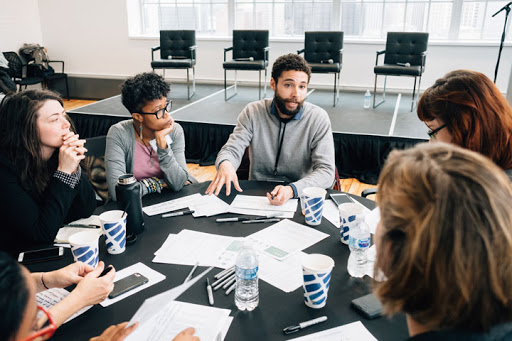Community Building at The Sprout Fund
Excerpts from this post originally appeared at http://fieldguide.sproutfund.org. This project was made possible with the generous support of the John D. and Catherine T. MacArthur Foundation.
From 2001 to 2018, The Sprout Fund helped foundations, nonprofits, companies, and governments make an impact on the issues they cared about most. Sprout began its work primarily as a Pittsburgh-based grantmaking organization: we worked with regional and national philanthropic partners to make more than $8 million of community-decided investments in more than 1,500 early-stage projects, organizations, innovators, and activities.
After 17 successful years, careful thought, and extensive planning with our board, The Sprout Fund decided to conclude our work in 2018. Upon our sunset as an organization this summer, we released a new publication to share what we learned along the way: The Sprout Fund Field Guide for Philanthropy & Civic Action. This Field Guide documents our lessons learned from 17 years of cultivating applications, making decisions, hosting events, leading community building campaigns, telling stories, and working with our grantees and our funders to achieve meaningful results together. It features a series of templates, instructions, and artifacts that can help you adapt our practices into your own grantmaking work.
The first section of the Field Guide details our Catalytic Funding work: our particular brand of community-driven, community-advised philanthropy. You can learn more about our work in this companion blog post here on the GEO blog.
Additionally, the Field Guide also shares tools to help others root their grantmaking in the communities they endeavor to serve. A key element of that work was our community building practice.

About Community Building at The Sprout Fund
In addition to providing catalytic funding to promising projects, Sprout also spent more than a decade forging connections between people working in service of critical social causes like education, art, and neighborhood development. Perhaps most importantly, we learned that complex problems require collaborative solutions. Our experience suggests that most problems cannot be solved in isolation; instead, we believe that positive change results when people openly collaborate to achieve shared goals.
We think the best description for this body of work is community building: the process of creating or enhancing connections among individuals within a specific geography or interest area. The people who lead this type of work are community builders: the advocates who use open practices to catalyze civic action.
True, authentic, and organic community building happens when people have ongoing opportunities to collaborate with one another and steadily increase their participation over time. This is important because relationships matter and they grow stronger through intentional collaboration.

We think that the most effective community building efforts make the most of participants’ time together. We value openness, which means sharing ideas, showing your work, and inviting contributions from others. We insist on recruiting diverse participants and we employ high-quality facilitators who help push the work forward.
Experience Design Principles
The core of community building is experience design: the work of developing purposeful and engaging activities that strengthen social cohesion. We believe in the power of engaging in meaningful dialogue, and we’re partial to face-to-face get-togethers. Digital experiences are valuable, to be sure, but we think the most productive, exciting work happens when people meet in person. Such events, when done well, foster productive relationships that enable people to collaborate intentionally and effectively over time.
To help people collaborate effectively, we believe in designing experiences that provoke discussion, spark insight, and forge lasting partnerships. We endeavor to create intentional arcs of activity that mobilize people to work together to achieve shared goals.

Over the past two decades, Sprout hosted hundreds of small- and large-scale events, from focus groups to multi-day festivals. While each event had its own goals and character, all Sprout events were guided by a series of principles that embody our comprehensive approach to experience design.
- Inclusive: Experiences should be community-based and accessible to all who want to participate.
- Purposeful: Experiences should be imbued with intent. Don’t host a meeting that should have been an email.
- Contextual: Experiences should honor history, acknowledge prior work, and be clearly situated in place and time.
- Participatory: Experiences should be participatory and interactive, and utilize co-design whenever possible.
- Catalytic: Experiences should create tangible after-effects that activate community members.
- Well-Documented: Experiences should generate shareable artifacts, including photos, videos, and other archival material.
At its core, community building is about creating the conditions for collaboration and facilitating connections between people. So long as you stay true to that mission, your work will surely continue to evolve and grow.
We hope you’ll use these stories, examples, and ideas as the starting point for your own community building work, no matter where you work or what you do. Moreover, we hope that the ideas and examples we’ve shared here will help other communities achieve their own meaningful, positive change. May these ideas inspire you to create more open, connected, and generous communities.
You can learn more about The Sprout Fund and the people, projects, and ideas that we supported at https://sproutfund.org.
Dustin Stiver, PhD, and Patricia Monticello Kievlan, EdM, served as the community building team at The Sprout Fund. Stiver worked at Sprout for more than 11 years, leading grant-making and community engagement programs, ultimately serving as Senior Program Officer. Monticello Kievlan served on the community building team from 2015 to 2018, after a decade of fostering teacher collaboration and edtech integration in schools. Now, they work with clients to design open, connected, and generous communities. You can connect with Stiver and Monticello Kievlan on LinkedIn and find them on Twitter at @DustinStiver and @PMKievlan.

